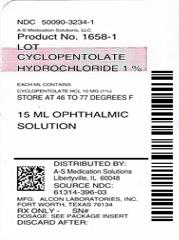DESCRIPTION
Cyclopentolate Hydrochloride Ophthalmic Solution USP is an anticholinergic prepared as a sterile, borate buffered, solution for topical ocular use. It is supplied in three strengths. The active ingredient is represented by the structural formula:

Established name: Cyclopentolate Hydrochloride
Chemical name: 2-(Dimethylamino)ethyl 1-hydroxy-a-phenylcyclopentaneacetate hydrochloride
Each mL contains: Active: cyclopentolate hydrochloride 0.5%, 1% or 2%. Preservative: benzalkonium chloride 0.01%. Inactives: boric acid, edetate disodium, potassium chloride (except 2% strength), sodium carbonate and/or hydrochloric acid (to adjust pH), purified water. The pH range is between 3.0 and 5.5.
CLINICAL PHARMACOLOGY
This anticholinergic preparation blocks the responses of the sphincter muscle of the iris and the accommodative muscle of the ciliary body to cholinergic stimulation, producing pupillary dilation (mydriasis) and paralysis of accommodation (cycloplegia). It acts rapidly, but has a shorter duration than atropine.
Maximal cycloplegia occurs within 25 to 75 minutes after instillation. Complete recovery of accommodation usually takes 6 to 24 hours. Complete recovery from mydriasis in some individuals may require several days. Heavily pigmented irides may require more doses than lightly pigmented irides.
CONTRAINDICATIONS
Should not be used when untreated narrow-angle glaucoma, or untreated anatomically narrow angles are present, or if the patient is hypersensitive to any component of this preparation.
WARNINGS
For topical ophthalmic use only. Not for injection. This preparation may cause CNS disturbances. This is especially true in younger age groups, but may occur at any age, especially with the stronger solutions. Infants are especially prone to CNS and cardiopulmonary side effects from cyclopentolate. To minimize absorption, use only 1 drop of 0.5% Cyclopentolate Hydrochloride Ophthalmic Solution USP per eye, followed by pressure applied over the nasolacrimal sac for two to three minutes. Observe infants closely for at least 30 minutes following instillation.
Mydriatics may produce a transient elevation of intraocular pressure.
PRECAUTIONS
General
The lacrimal sac should be compressed by digital pressure for two to three minutes after instillation to reduce excessive systemic absorption. Caution should be observed when considering use of this medication in the presence of Down's syndrome and in those predisposed to angle-closure glaucoma.
Information for Patients
Do not touch dropper tip to any surface, as this may contaminate the solution. A transient burning sensation may occur upon instillation. Patients should be advised not to drive or engage in other hazardous activities while pupils are dilated. Patients may experience sensitivity to light and should protect eyes in bright illumination during dilation. Parents should be warned not to get this preparation in their child's mouth and to wash their own hands and the child's hands following administration. Feeding intolerance may follow ophthalmic use of this product in infants. It is recommended that feeding be withheld for four (4) hours after examination.
Drug Interactions
Cyclopentolate may interfere with the ocular anti-hypertensive action of carbachol, pilocarpine, or ophthalmic cholinesterase inhibitors.
Carcinogenesis, Mutagenesis, Impairment of Fertility
Studies in animals or humans have not been conducted to evaluate the carcinogenic potential of Cyclopentolate Hydrochloride Ophthalmic Solution USP.
Pregnancy
Pregnancy Category C. Animal reproduction studies have not been conducted with cyclopentolate. It is also not known whether cyclopentolate can cause fetal harm when administered to a pregnant woman or can affect reproduction capacity. Cyclopentolate should be administered to a pregnant woman only if clearly needed.
Nursing Mothers
It is not known whether this drug is excreted in human milk. Because many drugs are excreted in human milk, caution should be exercised when cyclopentolate hydrochloride is administered to a nursing woman.
Pediatric Use
Use of cyclopentolate has been associated with psychotic reactions and behavioral disturbances in pediatric patients. Increased susceptibility to cyclopentolate has been reported in infants, young children, and in children with spastic paralysis or brain damage. These disturbances include ataxia, incoherent speech, restlessness, hallucinations, hyperactivity, seizures, disorientation as to time and place, and failure to recognize people. Feeding intolerance may follow ophthalmic use of this product in infants. It is recommended that feeding be withheld for four (4) hours after examination. Observe infants closely for at least 30 minutes (See WARNINGS).
ADVERSE REACTIONS
Ocular: Increased intraocular pressure, burning, photophobia, blurred vision, irritation, hyperemia, conjunctivitis, blepharoconjunctivitis, punctate keratitis, synechiae have been reported.
Non-ocular: Use of cyclopentolate has been associated with psychotic reactions and behavioral disturbances, usually in children, especially with 2% concentration. These disturbances include ataxia, incoherent speech, restlessness, hallucinations, hyperactivity, seizures, disorientation as to time and place, and failure to recognize people. This drug produces reactions similar to those of other anticholinergic drugs, but the central nervous system manifestations as noted above are more common. Other toxic manifestations of anticholinergic drugs are skin rash, abdominal distention in infants, unusual drowsiness, tachycardia, hyperpyrexia, vasodilation, urinary retention, diminished gastrointestinal motility and decreased secretion in salivary and sweat glands, pharynx, bronchi and nasal passages. Severe manifestations of toxicity include coma, medullary paralysis and death.
OVERDOSAGE
Excessive dosage may produce behavioral disturbances, tachycardia, hyperpyrexia, hypertension, elevated intraocular pressure, vasodilation, urinary retention, diminished gastrointestinal motility and decreased secretion in salivary and sweat glands, pharynx, bronchi and nasal passages. Patients exhibiting signs of overdosage should receive supportive care and monitoring.
DOSAGE AND ADMINISTRATION
Adults: Instill one or two drops of 0.5%, 1% or 2% solution in the eye which may be repeated in five to ten minutes if necessary. Complete recovery usually occurs in 24 hours. Complete recovery from mydriasis in some individuals may require several days. Children: Instill one or two drops of 0.5%, 1% or 2% solution in the eye which may be repeated five to ten minutes later by a second application of 0.5% or 1% solution if necessary. Small Infants: A single instillation of one drop of 0.5% Cyclopentolate Hydrochloride Ophthalmic Solution in the eye. To minimize absorption, apply pressure over the nasolacrimal sac for two to three minutes. Observe infant closely for at least 30 minutes following instillation. Individuals with heavily pigmented irides may require higher strengths.
